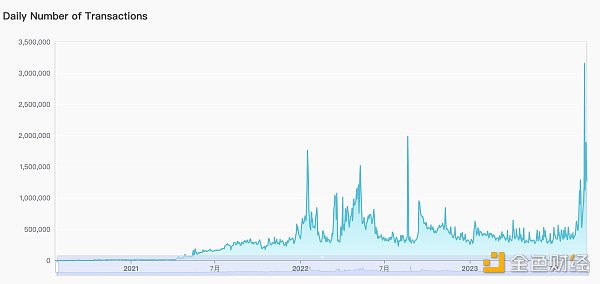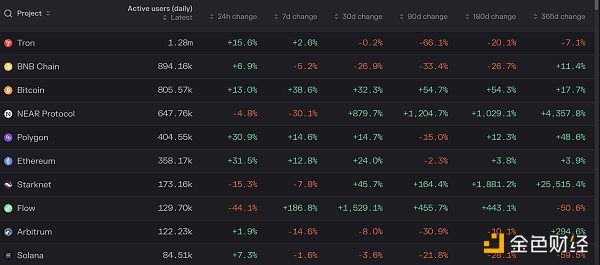NEAR’s number of users and transaction volume skyrocketed, possibly influenced by the token reward program of KaiKai, a chain upgrade.
NEAR's user and transaction numbers surged, potentially driven by KaiKai's token reward program during the chain upgrade.Author: Nancy, LianGuaiNews
While the battle for Layer2 is in full swing, the Layer1 networks that were hot in the previous cycle appear to be much quieter, with the on-chain activity of many Layer1 networks reaching freezing point. However, recently, the on-chain data of the NEAR Protocol, which has been quiet for a long time, has seen a significant increase, with a surge in both the number of users and transaction volume. This growth is attributed to the shopping platform KaiKai, especially since the platform launched a token reward program that offers multiple times the rewards this month.
KaiKai is not a native crypto project on the Near network; it is a “blockchain version” shopping platform under Cosmose AI, a consumer shopping data analysis platform in which NEAR Protocol has invested.
Since September, the on-chain activity of the NEAR Protocol has started to rise significantly. According to NEAR’s official block explorer, as of September 12th, the daily transaction volume has exceeded 1.49 million transactions, and the number of daily active accounts is about 680,000. Among them, NEAR reached its historical peak in various data on September 5th, with a daily transaction volume of about 3.165 million transactions, a daily active account number of about 926,000, and a daily Gas usage of over 35,000 NEAR tokens. Before that, most of NEAR’s daily transaction volume was between 300,000 and 500,000 transactions, and the number of daily active accounts was generally less than 100,000.
- LianGuaiWeb3.0 Daily | LianGuai Launches Cryptocurrency to USD Exchange Service
- ABCDE Why We Invest in GasZero
- Did airdrops ruin cryptocurrencies?

According to Token Terminal data, in the past 30 days, the number of daily active users of NEAR Protocol has exceeded Ethereum, Polygon, and Starntet, with a growth of about 879.7% in the past 30 days.

According to NEAR’s block explorer, in the past 14 days, the top 10 most active contracts, named “KAI-Ching,” have consistently had the highest number of transactions. In the past two weeks, they have created a total of 19.546 million transactions.
At the same time, according to data tracked by DappRadar, as of September 12th, KAI-Ching has a daily UAW (users acquired per week) of over 580,000 and a daily transaction volume of about 584,000 transactions.

It is worth mentioning that KaiKai launched a shopping reward program in September this year, where users who shop with the KaiKai App can earn double or even triple KAI-Ching tokens. This may also be the direct reason for the sudden surge in NEAR’s data.
KAI-Ching is actually a native stablecoin on the NEAR network, operated by Cosmose AI, and pegged to the US dollar. Cosmose AI is a consumer shopping data analysis platform established in 2014, serving over 20 million stores and 1 billion users worldwide. Its clients include top brands such as LVMH, GUCCI, BURBERRY, Cartier, Tencent, and Estée Lauder.
Cosmose AI uses AI analysis to track in-store foot traffic and interact with online shoppers. Its retail solution suite includes the KaiKai application, which allows customers to discover nearby retail stores and online positioning platforms. Among them, KaiKai is the flagship product of Cosmose AI, incorporating elements of shopping, retail, and gamification, and supporting brands such as NIKE, Samsung, Apple, Celine, and Nintendo Switch. According to the official introduction, the features provided by KaiKai include limited-time exclusive Product Drops, AR technology, live streaming featuring celebrities and influencers, rewards for collecting products and writing reviews, and access to the NEAR wallet through the KaiKai application.
In April of this year, the NEAR Foundation announced a strategic investment in Cosmose AI with a valuation of $500 million. According to the collaboration plan, Cosmose AI and KaiKai will undergo a blockchain upgrade through the NEAR protocol, and the two parties will establish a stablecoin payment system that allows users to shop with cryptocurrencies at lower transaction fees.
According to official sources, KaiKai has launched a blockchain-based loyalty program and created a native cryptocurrency called “Kai-Ching”. Users can earn additional Kai-Ching tokens while playing and shopping on the platform, similar to any other retail reward program. The difference is that Cosmose AI can provide more personalized recommendations and reward suggestions. Customers can easily use the native KaiKai cryptocurrency wallet to make transactions on the NEAR blockchain. At the same time, KaiKai has also created a cryptocurrency wallet for users, where they can exchange fiat currency for Kai-Ching, and of course, the token can also be exchanged back into fiat currency. For this purpose, Cosmose has also created a vault for Kai-Ching, which is pegged to the USD at a rate of 1 Kai-Ching = 1 cent, and can only be traded within the application to prevent value fluctuations. However, according to KaiKai, the platform is working hard to obtain the necessary licenses to enable KAI-CHING to be traded in the future.
As for the choice of blockchain upgrade, according to Cosmose AI, third-party payment companies like Stripe and LianGuaiyLianGuail charge more than 10% for small transactions. Therefore, sellers can only raise prices and force buyers to pay an additional 6% – 10% in fees. Cryptocurrency payment systems can significantly reduce transaction costs.
In addition, although Cosmose AI has not publicly disclosed the exact number of its encrypted users, it revealed that one-third of transactions are paid with Kai-Ching, and 83.5% of users are from Generation Z.
In conclusion, public chains are important infrastructure in the Web3 field and one of the most competitive tracks. Currently, in addition to building technological barriers, projects like NEAR and Polygon are transforming into tools for Web2, allowing Web3 technology to be used by more users outside of the crypto community, thus building their own advantages. From the current perspective, this strategy has shown initial effectiveness.
We will continue to update Blocking; if you have any questions or suggestions, please contact us!
Was this article helpful?
93 out of 132 found this helpful
Related articles
- Has the long-standing resentment towards VC finally erupted? After falling out with LianGuairadigm, Reflexer bought back tokens and put on a mocking face.
- US CFTC Commissioner Proposing the Establishment of Fraud Database to Identify Bad Actors
- Intent The Starting Point of Web3 Interactive Intelligence
- Principle, Current Application Status, and Risk Response of Intent
- SEC Pierce The US government needs to remember who they serve.
- FTX owns 38 properties in the Bahamas worth over 200 million US dollars.
- Huobi Ventures’ latest research report Will the Web3 social track be the next bull market engine?






